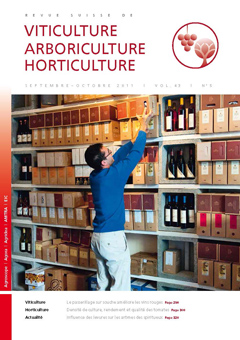
Issue 5 - September - October 2011
Abstract in open access
The effect of different thinning methods (elimination of whole or half bunches, gibberellins or prohexadione-calcium applications) has been studied during three years on the cultivar Gamay, clone RAC 10 under field conditions (experimental plots of Agroscope-ACW, Leytron VS, Switzerland). The application of gibberellins or prohexadionecalcium, as well as the half-section of bunches have significantly reduced the incidence of bunch rot. Chemical methods have caused bunch thinning by reducing flower fecundation. Gibberellins at 25 and 50 ppm has excessively reduced bloom induction. Prohexadione-calcium had no significant effect in yield reduction. Most composition was only slightly influenced by the different thinning techniques used.
Keywords: grapevine, gibberellins, GA3, hand-thinning, chemical-thinning, grey rot, Botrytis cinerea, clusters morphology, yield regulation, Gamay.
E-Mail: jean-laurent.spring@acw.admin.ch
Adress:
Abstract in open access
This article aims at drawing an objective report on qualities and drawbacks of Bag-In- Boxes® (BIB) used for the storage of wine («cask wine»). Two experiments were carried out. The first one compared the influences on wines stored in opened BIBs, closed BIBs and in glass bottles with cork closures. The second experiment evaluated the influence of storage temperature on wines in BIB. Included in this article are technical advises pointing out the specific characteristics of BIB packaging material, still fairly unknown to many consumers and Swiss winemakers. The BIB packaging material proved to be useful for wines to be consumed rapidly. It is lighter and cheaper than glass bottles. CO2 output for production and transportation is clearly lower. However, its permeability for gases supplies the wine less protection against oxidation, and generates aroma and CO2 losses. Using BIB packaging method needs skills and technical understanding for proper and satisfactorily use.
Keywords: Bag-In-Box®, permeability, oxygen, wine conservation, sensory analysis.
E-Mail: julien.ducruet@eichangins.ch
Adress:
Abstract in open access
On-vine grape drying with pruning of the fruit branch leads to must enrichment and has a positive effect on the wine. This technique is however linked to a yield loss and its success depends on the climatic conditions. Several trials were carried out from 2002 to 2008 in the Swiss regions of Tessin and Valais with Merlot, Pinot noir and Gamay in order to compare onvine with off-vine grape drying or with a strong restriction of grape yield. The benefit of onvine grape drying on the quality of Merlot wine in Tessin was confirmed. Interesting effects were also observed on Pinot noir in Valais although sugar accumulation can be too excessive. Off-vine grape drying under controlled conditions had similar effects to on-vine grape drying on must quality, but with lower influence on wine quality. Strong restriction of grape yield was considerably less effective on wine quality than on-vine grape drying.
Keywords: double ripening, wine quality, enrichment, yield restriction, on-vine grape drying, off-wine grape drying
E-Mail: johannes.roesti@acw.admin.ch
Adress:
Abstract in open access
The density of tomato cultivated on substrate is generally of 2.5 stems/m2. During cultivation, side shoots are selected to reach 2.8 stems/m2. To improve yields and profitability of cultivation, possibilities could be to raise the density by increasing the number of side shoots or to plant directly at a higher density. To answer this question, density tests were carried out at Agroscope Changins Wädenswil ACW in 2009 and 2010. In 2009, a standard variant, planted at 2.5 stems/m2 and increased to 2.8 stems/m2 by selection of side shoots, was compared to the same initial planting density increased to 3.5 stems/m2. In 2010, a variant directly planted at 3.75 stems/m2 was added. The raise of density from 2.8 to 3.5 stems/m2, respectively to 3.75 stems/m2 increased yields by approximately 15 %. However, there was no significant production gain between the plantation at a low density with addition of side shoots and direct plantation at high density. Contrary to the yield, density slightly influenced fruit quality.
Keywords: yield, quality, glasshouse
E-Mail: cedric.camps@agrocope.admin.ch
Adress:

 Download of full issue
Download of full issue
 Download article
Download article